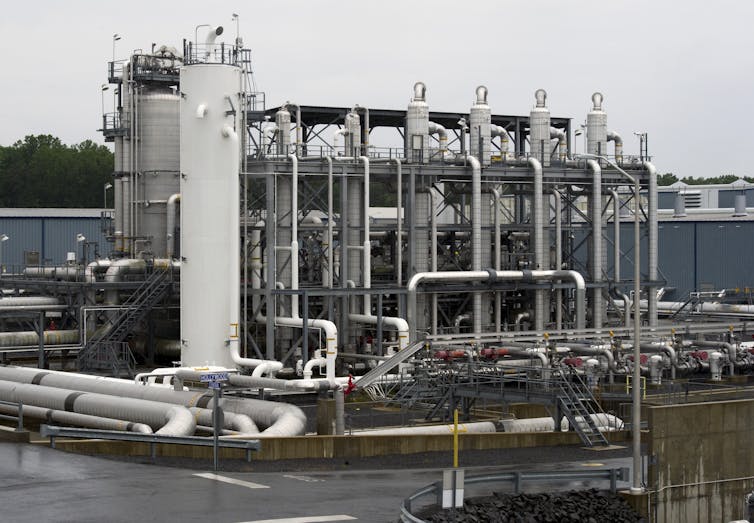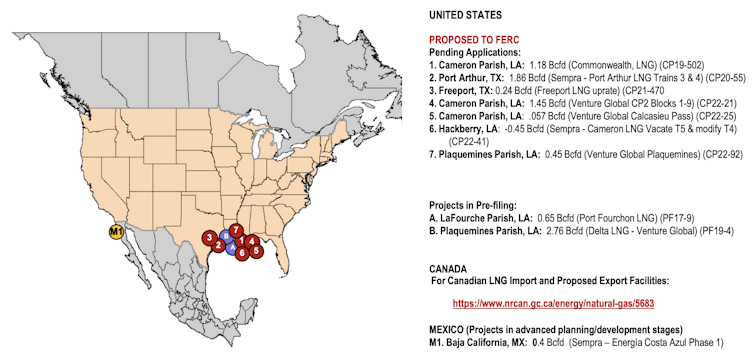Biden’s ‘hard look’ at liquefied natural gas exports raises a critical question: How does natural gas fit with US climate goals?

By Emily Grubert, University of Notre Dame
The Biden administration has frozen pending decisions on permit applications to export liquefied natural gas, or LNG, to countries other than U.S. free trade partners. During this pause, which will last for up to 15 months, the administration has pledged to take a “hard look” at economic, environmental and national security issues associated with exporting LNG.
Environmental advocates, who have expressed alarm over the rapid growth of U.S. LNG exports and their effects on Earth’s climate, praised this step. Critics, including energy companies and members of Congress, argue that it threatens European energy security and energy jobs in the U.S. Emily Grubert, associate professor of sustainable energy policy at the University of Notre Dame and a former official at the U.S. Department of Energy, explains why large-scale LNG exports raise complex questions for U.S. policymakers.
Is the US a major LNG supplier?
The U.S. is now the world’s largest LNG exporter. In November 2023, the most recent month with full data, the U.S. exported about 390 billion cubic feet of LNG, a record high.
The U.S. has been a net exporter since 2017, with export volumes now equal to about 15% of our domestic consumption. This gas sells for higher prices than natural gas delivered domestically, but it also costs more to process and deliver. As of 2022, the U.S. provided 20% of total global LNG exports.
Are there plans for exporting even more LNG?
The U.S. Energy Administration projects that North American LNG export capacity – largely from the U.S. – is likely to more than double from its current level by the end of 2027. In the U.S., five LNG export terminals are currently under construction, and are not affected by the current pause.
Applications for additional export terminals are under review. These are the applications for which decisions have been temporarily paused.

How does LNG fit into a transition away from fossil fuel?
LNG, and natural gas in general, has an uneasy place in the decarbonization transition. Natural gas is a fossil fuel. Burning it produces carbon dioxide that contributes to climate change.
Furthermore, natural gas that has been processed for use is essentially pure methane, which is itself a greenhouse gas. When natural gas leaks to the atmosphere from sources like wells, pipelines or processing plants, it adds to climate change. Since the mid-1800s, human activities – mainly, burning fossil fuel – have raised Earth’s temperature by roughly 2 degrees Fahrenheit (1.1 Celsius) above preindustrial levels. Methane has caused about 0.9 degrees F (0.5 C) of that warming above preindustrial global temperatures.
LNG is not a transition away from fossil fuel – it is a fossil fuel. Hypothetically, substituting LNG for more carbon-intensive fuels, like coal or other natural gas supplies with higher methane emissions, could help reduce greenhouse gas emissions in the near term.
But there’s debate over how much LNG is actually useful in that context, especially when it comes to whether LNG would actually prompt switching from coal to gas, and if so, whether the long-term lock-in of fossil gas use is worth it. Meanwhile, investing in new LNG infrastructure means either committing to operate these facilities for years, or planning to strand expensive assets by retiring them early.
LNG terminals also have significant local impacts. In addition to methane, they emit large quantities of other air pollutants, including nitrogen oxides and volatile organic compounds. Tanker traffic to and from them can damage marshes and waterways. Building more terminals, especially in areas where energy facilities are already concentrated, raises important health and environmental justice concerns.
A transition to net-zero greenhouse gas emissions will require a commitment to actually shift away from fossil fuel. In my view, it’s not clear that deploying LNG will achieve this goal unless it’s done with an explicit plan and mechanism to ensure that the gas is only used where it is actually needed and can support an emissions phaseout.
What do you think this policy review should consider?
As I see it, the most important step is to develop a coherent national strategy for the role of natural gas in the U.S. energy system, consistent with the Biden administration’s stringent goals of making the U.S. electricity supply carbon-free electricity by 2035 and achieving a net-zero greenhouse gas economy by 2050.
Such a blueprint would need to include a plan for reshaping the nation’s energy infrastructure to phase out use of natural gas, along with coal and oil. In theory, it could include targeted deployment of gas resources to ensure that energy needs are being met while zero-carbon resources are deployed along the way.
I’d like to see a clear articulation of the climate, health and energy system impacts of approving additional LNG export terminals, with enforcement mechanisms in place to ensure that the U.S. will meet defined limits on climate and other pollution, and on operational conditions. I’d also like to see health and environmental justice considerations deeply embedded into energy and climate decisions in general, and especially for LNG projects.
These plants are sited mainly in communities that have suffered high rates of illness, premature deaths and environmental damage from hosting fossil fuel infrastructure for decades. Many of them have said they don’t want additional LNG development. In my view, without clarity on where the U.S. is going on this issue, it will be extremely difficult to make good decisions about LNG, and about natural gas in general.![]()
Emily Grubert, Associate Professor of Sustainable Energy Policy, University of Notre Dame
This article is republished from The Conversation under a Creative Commons license. Read the original article.



